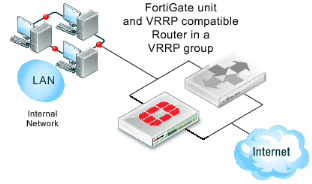VRRP

FortiGate units can function as master or backup Virtual Router Redundancy Protocol (VRRP) routers and can be quickly and easily integrated into a network that has already deployed VRRP. A FortiGate unit can be integrated into a VRRP group with any third-party VRRP devices and VRRP can provide redundancy between multiple FortiGate units.
In a VRRP configuration, when a FortiGate unit operating as the master unit fails, a backup unit takes its place and continues processing network traffic. If the backup unit is a FortiGate unit, the network continues to benefit from FortiOS security features. If the backup unit is a router, after a failure traffic will continue to flow, but FortiOS security features will be unavailable until the FortiGate unit is back on line. You can include different FortiGate models in the same VRRP group.
FortiOS supports VRRP between two or more FortiGate units and between FortiGate units and third-party routers that support VRRP. Using VRRP you can assign VRRP routers as master or backup routers. The master router processes traffic and the backup routers monitor the master router and can begin forwarding traffic if the master fails. Similar to the FGCP you can configuration VRRP between multiple FortiGate units to provide redundancy. You can also create a VRRP group with a FortiGate units and any routers that support VRRP.
In a VRRP configuration that consists of one FortiGate unit and one router, normally the FortiGate unit would be the master and all traffic would be processed by the FortiGate unit. If the FortiGate unit fails, all traffic switches to the router. Network connectivity is maintained even though FortiGate security features will be unavailable until the FortiGate unit can is back on line.
 FortiGate units can function as master or backup Virtual Router Redundancy Protocol (VRRP) routers and can be quickly and easily integrated into a network that has already deployed VRRP. A FortiGate unit can be integrated into a VRRP group with any third-party VRRP devices and VRRP can provide redundancy between multiple FortiGate units.
FortiGate units can function as master or backup Virtual Router Redundancy Protocol (VRRP) routers and can be quickly and easily integrated into a network that has already deployed VRRP. A FortiGate unit can be integrated into a VRRP group with any third-party VRRP devices and VRRP can provide redundancy between multiple FortiGate units.